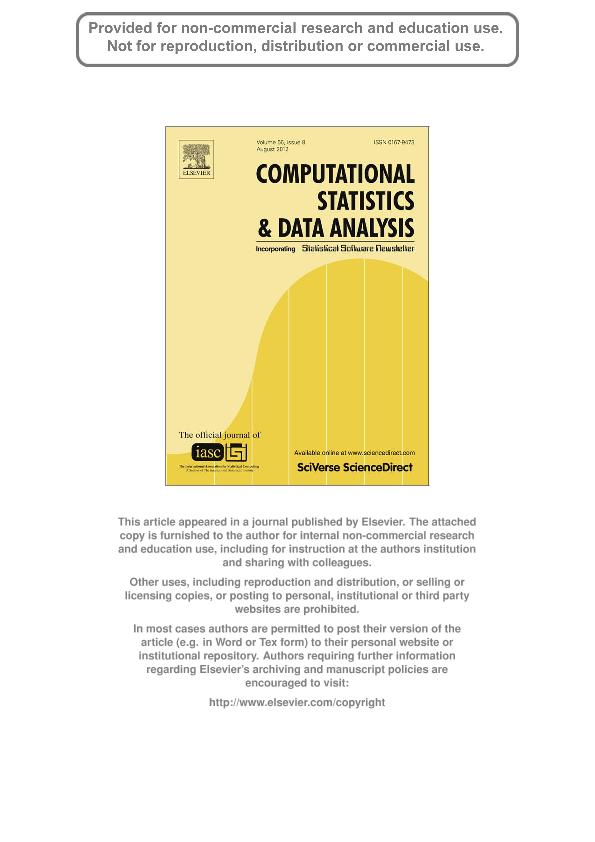Mostrar el registro sencillo del ítem
dc.contributor.author
Rulloni, Valeria Soledad

dc.contributor.author
Bustos, Oscar Humberto

dc.contributor.author
Flesia, Ana Georgina

dc.date.available
2023-03-16T10:40:51Z
dc.date.issued
2012-08
dc.identifier.citation
Rulloni, Valeria Soledad; Bustos, Oscar Humberto; Flesia, Ana Georgina; Large gap imputation in remote sensed imagery of the environment; Elsevier Science; Computational Statistics and Data Analysis; 56; 8; 8-2012; 2388-2403
dc.identifier.issn
0167-9473
dc.identifier.uri
http://hdl.handle.net/11336/190699
dc.description.abstract
Imputation of missing data in large regions of satellite imagery is necessary when the acquired image has been damaged by shadows due to clouds, or information gaps produced by sensor failure. The general approach for imputation of missing data, which could not be considered missed at random, suggests the use of other available data. Previous work, like local linear histogram matching, takes advantage of a co-registered older image obtained by the same sensor, yielding good results in filling homogeneous regions, but poor results if the scenes being combined have radical differences in target radiance due, for example, to the presence of sun glint or snow. This study proposes three different alternatives for filling the data gaps. The first two involves merging radiometric information from a lower resolution image acquired at the same time, in the Fourier domain (Method A), and using linear regression (Method B). The third method considers segmentation as the main target of processing, and proposes a method to fill the gaps in the map of classes, avoiding direct imputation (Method C). All the methods were compared by means of a large simulation study, evaluating performance with a multivariate response vector with four measures: Q, RMSE, Kappa and Overall Accuracy coefficients. Differences in performance were tested with a MANOVA mixed model design with two main effects, imputation method and type of lower resolution extra data, and a blocking third factor with a nested sub-factor, introduced by the real Landsat image and the sub-images that were used. Method B proved to be the best for all criteria.
dc.format
application/pdf
dc.language.iso
eng
dc.publisher
Elsevier Science

dc.rights
info:eu-repo/semantics/openAccess
dc.rights.uri
https://creativecommons.org/licenses/by-nc-sa/2.5/ar/
dc.subject
FILLING GAPS
dc.subject
IMPUTATION
dc.subject
REMOTE SENSED IMAGERY
dc.subject.classification
Estadística y Probabilidad

dc.subject.classification
Matemáticas

dc.subject.classification
CIENCIAS NATURALES Y EXACTAS

dc.title
Large gap imputation in remote sensed imagery of the environment
dc.type
info:eu-repo/semantics/article
dc.type
info:ar-repo/semantics/artículo
dc.type
info:eu-repo/semantics/publishedVersion
dc.date.updated
2023-03-15T20:27:31Z
dc.journal.volume
56
dc.journal.number
8
dc.journal.pagination
2388-2403
dc.journal.pais
Países Bajos

dc.journal.ciudad
Amsterdam
dc.description.fil
Fil: Rulloni, Valeria Soledad. Universidad Nacional de Córdoba. Facultad de Matemática, Astronomia y Física. Sección Matemática; Argentina. Consejo Nacional de Investigaciones Científicas y Técnicas. Centro Científico Tecnológico Conicet - Córdoba. Centro de Investigación y Estudios de Matemática. Universidad Nacional de Córdoba. Centro de Investigación y Estudios de Matemática; Argentina
dc.description.fil
Fil: Bustos, Oscar Humberto. Consejo Nacional de Investigaciones Científicas y Técnicas. Centro Científico Tecnológico Conicet - Córdoba. Centro de Investigación y Estudios de Matemática. Universidad Nacional de Córdoba. Centro de Investigación y Estudios de Matemática; Argentina. Universidad Nacional de Córdoba. Facultad de Ciencias Exactas, Físicas y Naturales. Departamento de Matemáticas; Argentina
dc.description.fil
Fil: Flesia, Ana Georgina. Universidad Nacional de Córdoba. Facultad de Matemática, Astronomía y Física; Argentina. Consejo Nacional de Investigaciones Científicas y Técnicas. Centro Científico Tecnológico Conicet - Córdoba. Centro de Investigación y Estudios de Matemática. Universidad Nacional de Córdoba. Centro de Investigación y Estudios de Matemática; Argentina
dc.journal.title
Computational Statistics and Data Analysis

dc.relation.alternativeid
info:eu-repo/semantics/altIdentifier/url/https://www.sciencedirect.com/science/article/pii/S0167947312001041
dc.relation.alternativeid
info:eu-repo/semantics/altIdentifier/doi/http://dx.doi.org/10.1016/j.csda.2012.02.022
Archivos asociados
